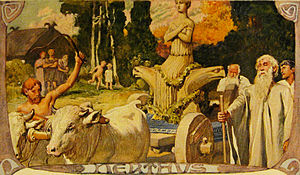Nerthus
Tacitus describes the wagon procession in some detail: Nerthus's cart is found on an unspecified island in the "ocean", where it is kept in a sacred grove and draped in white cloth.
Additionally, scholars have sought to explain the difference in gender between the early Germanic and Old Norse forms of the deity, discussed potential etymological connections to the obscure female deity name Njörun, mention of the mysterious Sister-wife of Njörðr, proposed a variety of locations for where the procession may have occurred (generally in Denmark), and considered Tacitus's sources for his description.
Scholars commonly identify the goddess Nerthus with Njörðr, a deity who is attested in Old Norse texts and in numerous Scandinavian place names.
Scholars identify the Romano-Germanic Nerthus as the linguistic precursor to the Old Norse deity name Njörðr and have reconstructed the form as Proto-Germanic *Nerþuz.
[4] According to McKinnell, "The meaning of the name has usually been connected with Old Irish nert 'strength' (so 'the powerful one'), but it might be related to Old English geneorð 'contented' and neorxnawang 'paradise' (literally 'field of contentment'), or to the word 'north' (i.e. 'deity of the northern people', cf.
The seven tribes are surrounded by rivers and forests and, according to Tacitus, there is nothing particularly worthy of comment about them as individuals, yet they are particularly distinguished as a group in that they all worship the goddess Nerthus.
While Tacitus appears to have been away from Rome during this period, he would have had plenty of opportunity to gain information provided by King Masyas and Ganna from those who spent time with the two during their visit.
[9] Of the various forms found in the extant Germania manuscript tradition, two have yielded significant discussion among scholars since at least the nineteenth century, Nerthus and Hertha.
He highlights the presence of the form in the Codex Aesinas (discovered in 1902, while Grimm died in 1863), and asks, "would it not be an extraordinary coincidence that a deity who fits the pattern of the later fertility gods should have a name that is etymologically identical with one of them?
For example, Anders Andrén says: Some scholars have proposed that the location of the Nerthus procession occurred on Zealand in Denmark.
Nerthus is then commonly compared to the goddess Gefjon, who is said to have plowed the island of Zealand from Sweden in the Prose Edda book Gylfaginning and in Lejre wed the legendary Danish king Skjöldr.
Njörðr is referred to as "god of wagons" (Old Norse vagna guð) in the principal manuscript of Skáldskaparmál (the Codex Regius).
Davidson says that the evidence suggests that similar customs as detailed in Tacitus's account continued to exist during the close of the pagan period through worship of the Vanir.
Various scholars have linked Tacitus's description of drowned slaves in a "lake" as a reference to the interment of human corpses in peat bogs.
For example, according to archaeologist Peter Vilhelm Glob: In his description of Nerthus, Tacitus refers to the goddess as "Mother Earth" (Terra Mater).
He concludes that "it seems likely that Tacitus equates Nerthus with Terra Mater as an interpretatio Romana, a translation into terms his Roman readers would find familiar.
"[26] John Lindow says that Tacitus's "identification with Mother Earth probably has much less to do with Jörd in Scandinavian mythology than with fertility goddesses in many cultures".
For example, Hertha and Herthasee (see "location" section above) play major roles in German novelist Theodor Fontane's 1896 novel Effi Briest.



